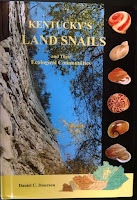 |
| Notice the hole in the center of the snail under the lip of the lowland pillsnail on the left. No hole on the upland pillsnail on the right. |
But land
snails aren’t the only land mollusk to be found. We have been overlooking slugs, which can be
found about anywhere on the preserve, for as long as we have been identifying
everything else. So now, with the
Dourson’s help, slugs shall not be overlooked from here on in.
One reason
slugs are overlooked is because of the lack of resources available for
identification. And with what is
available, slugs still are not an easy subject.
But lucky for us, Dan has written a few books that can be helpful to
Ohio naturalists. Kentucky’s Land
Snails and Their Ecological Communities, Land Snails of West Virginia
and Land Snails of the Great Smoky Mountains National Park and Southern
Appalachians. These books have most
if not all of the snails and slugs that can be found in Ohio, especially
southern Ohio.
So I wanted
to try to use Dan’s Kentucky book to identify slugs that I come across. That’s when this little creature appeared, on
lettuce brought from the preserve Director’s garden. Luckily, before accidentally eating it, it made its way into
the lab for further study. From Dan’s
book I learned that if a slug has a “saddle” on its back, it’s probably a
non-native slug from Europe. Apparently,
most of the slugs we come across, especially in yards and gardens are exotic
species. This little slug had a saddle,
but I found that there is one species of native slug possessing a saddle. Unfortunately, it is virtually identical to a
non-native relative. Only dissection can
determine the correct identification.
But since this slug was in a garden, near a dwelling with many exotic
plants and soil brought in for gardening, it is most likely the non-native Deroceras panormitanum, the longneck
field slug. Under a dissecting scope with
good light you could really see the markings and patterns of this
creature. With this view, the patterns
matched up with the Deroceras
species, and the size of the animal along with the position of the saddle
helped separate it from other genera.
 |
| Deroceras panormitanum, the longneck fieldslug. Notice the "saddle" on its back. |
I put the slug on the bark a few more times, and every time I did, it tried escaping the same way. Why waste time crawling when you can rappel to get away. I’d never have guessed that picking up this one slug would be so educational. I guess that it produces the slime while it’s hanging in mid-air and slowly can lower itself to the bottom. And if they can hang there for periods of time, I would imagine this could be a great retreat from predators.
 |
| Longneck fieldslug making its escape. |
 |
| Slowly rappelling away. |
 |
| Head first seems a bit dangerous, but that's a slug for you. |
 |
| Arrived at the bottom, unfortunately for the slug it's a large table and could be re-captured. |
If you would like to learn interesting facts about slugs like their practice of stabbing love darts into their partners while mating, their abilities to eat highly toxic mushrooms to beef up their defense mucous, slugs anti-bacterial properties that help humans or most importantly how to identify them and their snail cousins, check out Dan’s books mentioned and pictured above. These books are not sold in stores or yet on a website. To buy one you must reach out to him personally at theroguebiologist@gmail.com.
Posted by: Mark Zloba


